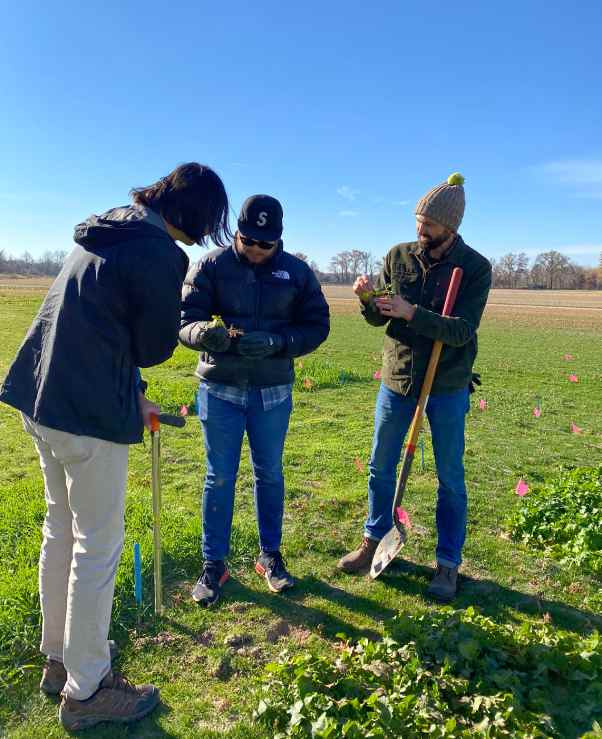Danforth Center Scientists Improve Cover Crops for Sustainable Ag
What's Old is New and Better
Cover crops were once common. Farmers from the ancient Romans to the Native Americans to George Washington recognized the benefits of crop diversity to their soil health—and to their harvests. Modern agriculture replaced the practice with synthetic nitrogen fertilizer—the source, we now realize, of many unintended negative consequences.
Today, in the face of erosion, pollution, and climate change, Danforth Center scientists like principal investigators Chris Topp, PhD, and Dmitri A. Nusinow, PhD, are working to improve cover crops for more rapid and widespread adoption. Said Topp: “Cover crops are an existing solution that’s right in front of us. They are almost immediately actionable if we can just get past a few hurdles.”

Danforth Center Postdoctoral Associate Kong Wong, PhD, Lab Assistant Mitchell Sellers, and Principal Investigator Chris Topp, PhD, check on plots of cover crop varieties being evaluated at the Danforth Center Field Research Site.
What are Cover Crops?
Simply put, cover crops are plants (often ryes, winter wheat, or legumes) grown between cycles of cash crops. Traditionally, they are not grown as crops themselves, but for “ecosystems services”; that is, the benefits they have to the soil and to other crops. Cover crops offer a variety of benefits, such as increased soil moisture capacity, weed suppression, and enhanced nutrient uptake. They can also reduce loss of soil, prevent fertilizer runoff, reduce flooding, and store carbon underground.
Yet with all these benefits, according to the USDA, just over 5 percent of available US farmland utilized cover crops in 2017. Why? Establishing a cover crop requires investment in, at minimum, seed and time (and sometimes machinery). There is a learning curve fraught with concerns for most farmers. And most cover crops have not been improved to modern standards.
Cover crops are an existing solution that’s right in front of us. They are almost immediately actionable if we can just get past a few hurdles.
Chris Topp, PhD, Danforth Center Principal Investigator
Getting to the Root of the Challenge
Improvement of ecosystem service performance is rarely considered as a breeding trait for crops due to the complexities and challenges of below-ground evaluation. However, the Topp lab’s creative adaptation of equipment from geology, hydrology, and the aeronautics industry is revolutionizing our ability to study roots. These advances in root phenotyping and genetic tools are critical in accelerating ecosystem service improvement in cover crops.
Right now the Topp lab is analyzing 30 species and varieties of cover crops at the Danforth Center Field Research Site. They are studying the root system architecture and capabilities, and tracking carbon and nitrogen flow in the soil and plants using isotopes. The goal: improved varieties and an eventual menu of options for farmers in order to de-risk the process of cover crop adoption, while obtaining maximum impact.
Helping a Leading Candidate Thrive
One especially strong cover crop candidate is pennycress (Thalspi arvensi). This common weed provides many ecological benefits: it protects soil from erosion, it draws down excess fertilizer, and, most exciting, in the hands of CoverCress, Inc., it is providing a third cash crop for farmers.
The Danforth Center's Dr. Nusinow is an expert on plant circadian rhythms. He was tapped to help validate new technology of CoverCress, when they were named a Wells Fargo IN2 company in 2019. Members of his lab are currently attempting to boost pennycress’s heat tolerance and ability to compete when planted at densities needed for soil protection. Both features will be important in the face of climate change.
“The need to protect the soil, to protect the environment is very pressing,” said Nusinow. “Farmers know it; they care. We’re pulling together to improve human health and the environment.”
Why It Matters
Science to address challenges at the nexus of agriculture and the environment has never been more important. That’s where the Danforth Center comes in. Danforth Center scientists are speeding plant science solutions to market to build a brighter future. Join us by supporting the Danforth Center today.
About
A version of this story originally appeared in the Leaflet, the free newsletter of the Donald Danforth Plant Science Center. Sign up to receive more stories like this straight to your inbox.